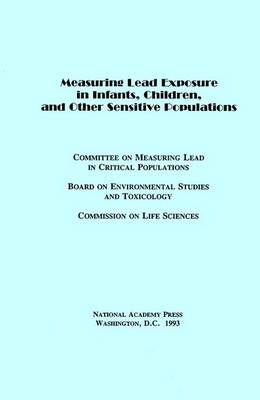
Measuring Lead Exposure in Infants, Children, and Other Sensitive Populations
Seiten
1993
National Academies Press (Verlag)
978-0-309-04927-6 (ISBN)
National Academies Press (Verlag)
978-0-309-04927-6 (ISBN)
Addresses the public health concern about the logistics and feasibility of lead screening in infants and children at low concentrations. This book serves as the basis for US Public Health Service activities and for state and local programs in monitoring lead.
Lead is a ubiquitous toxic agent that is especially damaging to the young child and the developing fetus. Unlike many environmental health risks, the risks associated with lead are no longer theoretical but have been observed for many years. Indeed, the first regulation of lead in paint was enacted in the 1920s.
Currently, because of growing evidence of lead toxicity at lower concentrations, the U.S. Centers for Disease Control and Prevention recently lowered its lead-exposure guideline to 10 ug/dl lead in blood from 25 ug/dl. Measuring Lead Exposure in Infants, Children, and Other Sensitive Populations addresses the public health concern about the logistics and feasibility of lead screening in infants and children at such low concentrations. This book will serve as the basis for all U.S. Public Health Service activities and for all state and local programs in monitoring lead.
Table of Contents
FRONT MATTER
EXECUTIVE SUMMARY
1 INTRODUCTION
2 ADVERSE HEALTH EFFECTS OF EXPOSURE TO LEAD
3 LEAD EXPOSURE OF SENSITIVE POPULATIONS
4 BIOLOGIC MARKERS OF LEAD TOXICITY
5 METHODS FOR ASSESSING EXPOSURE TO LEAD
6 SUMMARY AND RECOMMENDATIONS
REFERENCES
Lead is a ubiquitous toxic agent that is especially damaging to the young child and the developing fetus. Unlike many environmental health risks, the risks associated with lead are no longer theoretical but have been observed for many years. Indeed, the first regulation of lead in paint was enacted in the 1920s.
Currently, because of growing evidence of lead toxicity at lower concentrations, the U.S. Centers for Disease Control and Prevention recently lowered its lead-exposure guideline to 10 ug/dl lead in blood from 25 ug/dl. Measuring Lead Exposure in Infants, Children, and Other Sensitive Populations addresses the public health concern about the logistics and feasibility of lead screening in infants and children at such low concentrations. This book will serve as the basis for all U.S. Public Health Service activities and for all state and local programs in monitoring lead.
Table of Contents
FRONT MATTER
EXECUTIVE SUMMARY
1 INTRODUCTION
2 ADVERSE HEALTH EFFECTS OF EXPOSURE TO LEAD
3 LEAD EXPOSURE OF SENSITIVE POPULATIONS
4 BIOLOGIC MARKERS OF LEAD TOXICITY
5 METHODS FOR ASSESSING EXPOSURE TO LEAD
6 SUMMARY AND RECOMMENDATIONS
REFERENCES
Committee on Measuring Lead in Critical Populations, National Research Council
1 FRONT MATTER; 2 EXECUTIVE SUMMARY; 3 1 INTRODUCTION; 4 2 ADVERSE HEALTH EFFECTS OF EXPOSURE TO LEAD; 5 3 LEAD EXPOSURE OF SENSITIVE POPULATIONS; 6 4 BIOLOGIC MARKERS OF LEAD TOXICITY; 7 5 METHODS FOR ASSESSING EXPOSURE TO LEAD; 8 6 SUMMARY AND RECOMMENDATIONS; 9 REFERENCES
| Erscheint lt. Verlag | 1.7.1993 |
|---|---|
| Verlagsort | Washington |
| Sprache | englisch |
| Maße | 152 x 229 mm |
| Themenwelt | Medizin / Pharmazie ► Medizinische Fachgebiete ► Arbeits- / Sozial- / Umweltmedizin |
| Studium ► 2. Studienabschnitt (Klinik) ► Pharmakologie / Toxikologie | |
| ISBN-10 | 0-309-04927-X / 030904927X |
| ISBN-13 | 978-0-309-04927-6 / 9780309049276 |
| Zustand | Neuware |
| Haben Sie eine Frage zum Produkt? |
Mehr entdecken
aus dem Bereich
aus dem Bereich
Buch | Hardcover (2024)
Thomas Karow (Verlag)
57,80 €
Buch | Hardcover (2022)
Urban & Fischer in Elsevier (Verlag)
99,00 €


